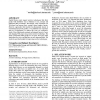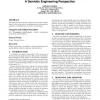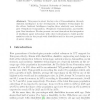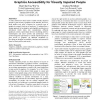110
click to vote
JCDL
2010
ACM
15 years 3 months ago
2010
ACM
Digital libraries must support assistive technologies that allow people with disabilities such as blindness to use, navigate and understand their documents. Increasingly, many doc...
ASSETS
2007
ACM
15 years 5 months ago
2007
ACM
This paper discusses semiotic engineering (a design methodology) and its potential for addressing issues concerning the adoption and configuration of assistive technologies. Categ...
ASSETS
2006
ACM
15 years 7 months ago
2006
ACM
This paper describes iNetSim, a universally accessible network simulator, created to allow vision-impaired and sighted users to complete Cisco Certified Network Associate level tw...
113
click to vote
IWANN
2007
Springer
15 years 7 months ago
2007
Springer
This paper is about the key role of Personalization through Ambient Intelligence in the development of Assistive Technologies for the elders. Ambient Intelligence implies three rel...
102
click to vote
HT
2009
ACM
15 years 7 months ago
2009
ACM
Web pages such as news and shopping sites often use modular layouts. When used effectively this practice allows authors to present clearly large amounts of information in a single...
CHI
2007
ACM
16 years 1 months ago
2007
ACM
CHI
2007
ACM
16 years 1 months ago
2007
ACM
To date, efforts have been made to enable visually impaired people to gain access to graphics on the Internet. However, these studies only offer a solution for a specific type of ...
CHI
2008
ACM
16 years 1 months ago
2008
ACM
Individuals with cognitive deficits and their families are prime examples of collaborative "systems" that seek to perform everyday tasks together. Yet there has been lit...
CHI
2009
ACM
16 years 1 months ago
2009
ACM
A long term goal of assistive technology research is to build creative expression applications where subjects can extemporaneously express themselves. Sketch drawing is one form o...




![Striking a c[h]ord: vocal interaction in assistive technologies, games, and more Striking a c[h]ord: vocal interaction in assistive technologies, games, and more](https://www.sciweavers.org/files/imagecache/thumbnail/imagecache/striking_a_c_h_ord_vocal_interaction_in_assistive_technologies_games_and_more_CHI_2007.jpg)
